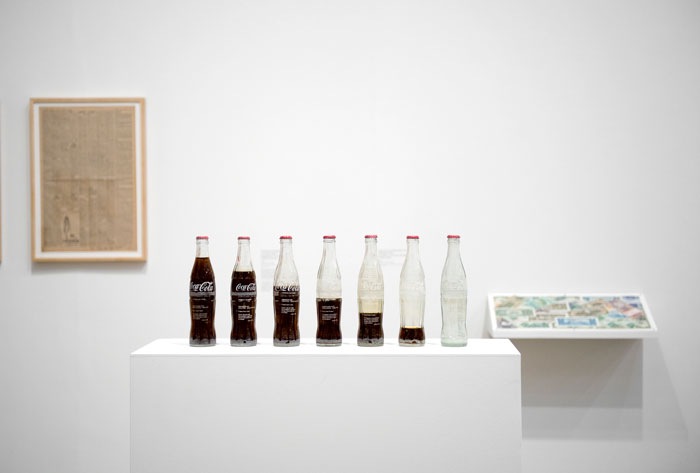Putting an Olive Stone into a Bottle
Insertions and Circuits – Circulation Mechanisms used by Brasilian Artist Cildo Meireles

Born in Brazil in 1948, leading conceptual artist Cildo Meireles was heavily influenced by the politics at that time, as well as the history of the indigenous Tupí people from the Amazon rainforest. His works are philosophical objects, or ‘material thoughts’, addressing issues ranging from political repression, economic inequality, and the impact of colonialism, but treating each issue with a poetic beauty. Since the late 1960’s, Meireles has experimented with a variety of media ranging from works on paper to large-scale installations using a wide range of materials including banknotes and coins, bottles, vinyl records, water, straw, gold, gas, fire, wood, metal, plastic and paper bags.
A basic theme running as a thread through Cildo Meireles’ work is the concept of circulation and distribution, with the idea of space as a circulatory network. The notion of circulation and exchange of goods, wealth and information as manifestations of the dominant ideology is the base for his project ‘Insertions into Ideological Circuits’ (1970), displayed at the Tate Modern in London. When asked how this series came about, he explained that while having a beer with a friend at a bar in Rio, his friend remarked that an olive stone could never be removed from a bottle unless the mechanical process for washing bottles was changed. As Meireles pictured this olive stone inside a bottle, he concluded that there are circulation mechanisms within society which could be used by artists as counter-information.
At that time around 1970, Coca-Cola bottles in Brazil circulated on a deposit system, so Meireles removed them from this system, modified them by adding critical political statements or instructions for turning the bottle into a Molotov cocktail, before returning them to the circuit of exchange.
Applying the same principle to banknotes, he stamped them with inscriptions such as ‘Who killed Herzog?’, referring to a journalist who had been tortured by the regime and died in prison. The Banknote Project was the most effective of the Insertions since the notes and the unwanted message circulated quickly, for people would neither keep the money nor destroy it. Within his further work with banknotes, he was extending his exploration of value, producing ‘Zero Dollar’ (1974-78) bills, spoofs of actual currency. Reducing the value of these bills to zero, Meireles replaced the illustrious figures who normally adorn banknotes with two people who existed on the margins of society with few legal rights: an inmate from an asylum he had visited in Trindade and a Krao Indian.

His ‘Zero Dollar’ was also featured in the Agent Artist exhibition curated by Thomas Büsch in New York City in 1994.
On the occasion of Brazil being guest of honor at this year’s Frankfurt Book Fair, the Schirn Kunsthalle Frankfurt is presenting a large exhibition on Brazilian installation art. Cildo Meireles is one of eight featured artsts who transform the Schirn from October 2nd 2013 to January 5th 2014 into a series of spaces that can be experienced intensely by the senses and installations into which viewers are directly integrated as participants.
The Insertions into ideological circuits is on view at Kunsthal 44 Møen, Denmark; Cildo Meireles first solo exhibition in Scandinavia.

